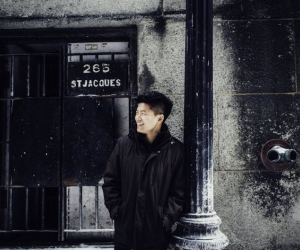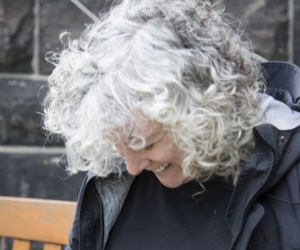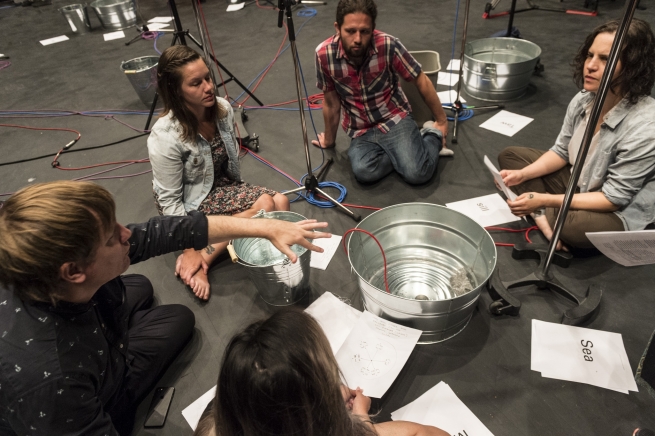
THE EIGHTH PROJECT initiated by the Edmonton-based Ociciwan Contemporary Art Collective, in memoriam . . . , was nominally about a performance, but soon morphed into a unique achievement of seemingly infinite layers. Its complex genesis, motivations, resonances, and residual impact on its participants transcend its basic idea. It conveys a distinctively humane and elevated notion of what a concert and recording project can be, while offering a singularly instructive model of what a collectively conceived artistic undertaking can achieve.
Established in 2015, the Ociciwan Contemporary Art Collective was formed with a mandate to develop innovative and experimental projects involving Indigenous artists. “We meet monthly, and everything is decided by consensus, so we all need to agree before we move forward with anything,” says core member Becca Taylor, a multidisciplinary artist, curator, and youth worker. “If there are serious concerns, we table it until we have more time to do research on it.”
The project began casually at a 2016 meeting, thanks to Kristy Trinier, another Ociciwan core member. “It was just this natural way of coming into existence for us,” Taylor relates. “Kristy was talking about graphic scores and we were flipping through a book, Yes, But Is It Edible?, on Robert Ashley’s work and were curious about his score, in memoriam . . . Crazy Horse. I had never seen anything like that before. We had many questions about why a non-Indigenous person was writing a piece for an Indigenous person, and wondered if it had ever been performed by Indigenous musicians, and what the consultation process was like, or if there was one?”
Trinier sought information from Alex Waterman, a former student and colleague of Ashley, and coauthor, with Will Holder, of Yes, But Is It Edible? Discussion ensued and subsequently Ociciwan invited Waterman and Holder to bring their expertise to the project.
It would be a full year and a half of preparation before in memoriam . . . was completely underway, and the team was still growing and discussing the four scores created by Robert Ashley in 1963: in memoriam . . . Crazy Horse (symphony), in memoriam . . . Esteban Gómez (quartet), in memoriam . . . John Smith (concerto), and in memoriam . . . Kit Carson (opera). Taylor recalls conversations from that time: “‘Wouldn’t it be incredible if we could perform this with Indigenous musicians? Let’s bring in [interdisciplinary arts collective] Postcommodity and see if they’d be interested in doing this project with us.’ Through those conversations we came to the question of, what does it look like for an Indigenous artist to perform a work written for a colonizer? We decided that the musicians should perform all four.”
Understanding their composition, titling, and deceptively abstract appearance requires some comprehension of Ashley’s concern with what he called “the history of American consciousness.” As Alex Waterman explains, the scores are not about trying to reflect a common history. “That idea is anathema . . . This isn’t a history of race or religion. This is a history of changes in consciousness. The only way we can really do that history is in listening to stories and music and looking at art and textiles, etc. It’s not about what the powerful people said or did . . . It’s how the little people and the forgotten people responded.”
For Postcommodity’s Raven Chacon, in memoriam . . . suggests a problematization of these figures: “It wasn’t about claiming or reclaiming the Crazy Horse piece. We should perform all four in memoriams. Why not? Why can’t we be the ones to perform the Kit Carson one, for example, especially with Kit Carson being an enemy to my people, the Navajo, and forcing us onto the Long Walk and trying to eliminate us.” For Chacon, the project was partially about “acknowledging and recognizing the ability of history to change, to be in flux, and reputations of people to morph or reveal themselves or dissolve away.”
By 2017 something remarkable was clearly underway. Learning, recording, and previewing were scheduled at the Banff Centre for early July, the premiere at the Winspear Centre in Edmonton soon after. Thirty more musicians were needed. Becca Taylor was Ociciwan’s lead for this. “We were looking at who was playing music in Alberta. We started looking at rock bands, heavy metal and punk, sound artists, throat singers . . . We decided to invite a variety of musicians and see what comes of it. It just naturally fit. A lot of our musicians had never seen anything like that. There was a little bit of hesitation, in the first rehearsal, from some, about how their music style would fit, and then at some point we said, ‘Let’s just try it,’ and the sound and conceptualization of what we were trying to achieve naturally started forming collectively from there.” The group became a tight unit, spending long days working on the project, teaching each other, walking, jamming, and digging into long, nocturnal discussions.
Prior to the Banff sessions, the group had made a key decision: create a fifth score with local concerns. “Ociciwan really took time and energy to do research on the fifth in memoriam . . ., we thought, What’s really important to us right now in this region? At the time, we were an all-female collective and were considering our relationships as Indigenous women. We really wanted to look at the history of the women that had come before us, and think about the region and the path that they’ve had and about how we could create an in-memoriam for that.”
Three Alberta women were chosen: Mary Cecil (Cree, dates unknown), a turn-of-the-twentieth-century midwife to Indigenous and settler mothers; Victoria Callihoo, née Belcourt (Métis, 1861–1966), a horsewoman, hunter, and elder; and Eleanor “Helene” Thomas Garneau (Métis, 1852–1912), a crucial figure in the Métis resistance.
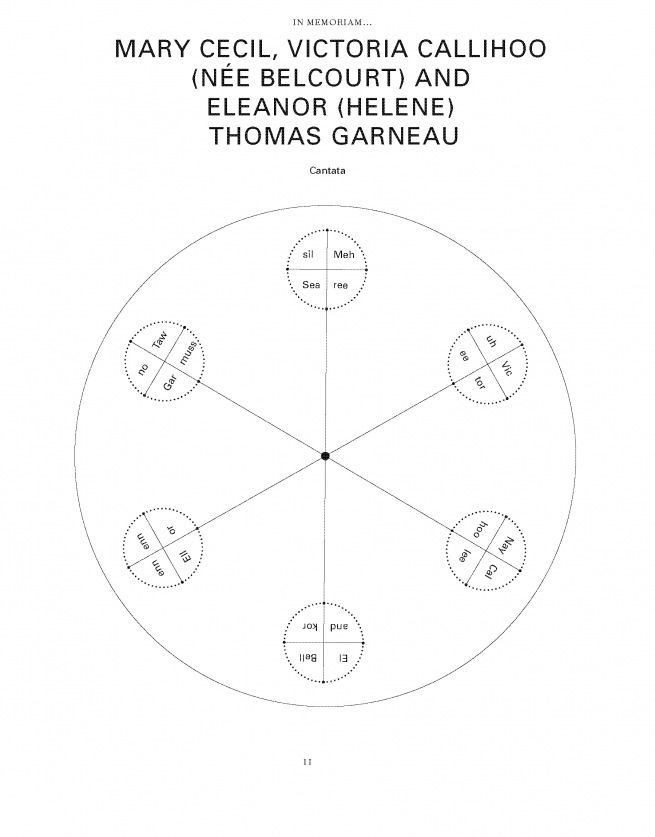
The fifth score gives direct space and name to the three women. Their names are divided into phonemes, and the performers are divided into groups with instructions to utter each phoneme sixteen times, each time for the length of a breath, along with a unique pitch or noise, determined by reading biographical material. An overall sonority is created by continuously dipping cloths in water, then hanging them to drip into metal basins, a reference to Eleanor Garneau, who, by calmly scrubbing them in a washtub, destroyed incriminating letters from Louis Riel to her husband while the Northwest Mounted Police searched her house.
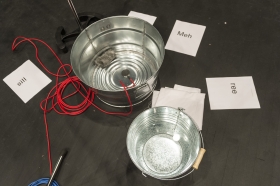

For Taylor and Ociciwan, the basin had a more complex meaning. “We were thinking a lot about water and the meaning it has for Indigenous women. Women are known as ‘water carriers’ and thinking about Mary Cecil and how integral water was to her practice as a midwife, as well as Eleanor ‘Helene’ Thomas Garneau’s use of water to wash away a letter that could be used as evidence against her husband and son.” After each section, the performers tear out the score pages containing the phonemes they have just sung, move to the centre, and destroy them, using scrubbing boards.
Intoning these names elicited a range of reactions and thoughts. “It was really interesting for me as a curator,” says Taylor. “I was up there singing with them and just thinking through the construction of names and thinking through our archives and how a lot of it is incomplete or not accurate as a historical resource. With these names I was just thinking about the lack of Indigenous women’s names and acknowledgment of their work in building nations in Canadian history. A lot of knowledge and memory is still carried in the families—and how do we give space and name people, the way they deserve to be acknowledged?”
Jump to September 2018, fourteen months after in memoriam . . . received an unforgettable performance at the Winspear Centre. Many of the of the artists and their friends reunited for a joyous LP-release party at The Black Dog Freehouse on Whyte Avenue. It was a night of songs, stories, spectacular improvisations, and a sense of both ending and beginning.
For Becca Taylor and Ociciwan, the simultaneous presence of the past, present, and future are vital to those who are alive now, and those who will be alive. “We have to honour our past and listen to our elders and think through those things. It’s our role as the present people to think about the next several generations. What is my role at this time? I do think a lot about past-present-future. It’s important for people to be sharing experiences through natural forms of mentorship.”
The author gratefully acknowledges that this article was written in Treaty Six territory.
AUDIO: Mary Cecil, excerpt from in memoriam . . . Mary Cecil, Victoria Callihoo (née Belcourt), and Eleanor (Helene) Thomas Garneau.
Top and bottom photos of rehearsal and recording at by Rita Taylor (Banff Centre). Middle photo: Score of in memoriam . . . Mary Cecil, Victoria Callihoo (née Belcourt), and Eleanor (Helene) Thomas Garneau.
